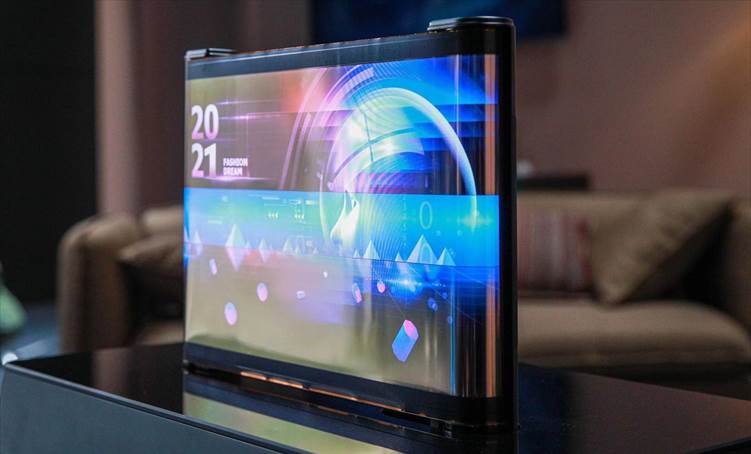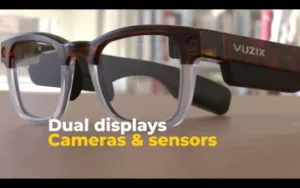Suppliers generally showcased their best and brightest next generation products at CES giving us a glimpse of what to expect in future. Some of these prototypes take years to show up in the consumer market and some never make it as commercially viable products. This year at virtual CES 2021 we got a glimpse of futuristic products as well as products that we can expect to see in 2021.
OLED Display: Evolving
OLED display technology is continuing to advance and evolve for next generation products.
Brighter OLED:
LG Display unveiled a new 77″ OLED display that uses new materials as well as addition of a layer to display to improve efficiency by around 20% enabling higher brightness. The company plans to bring its advanced next gen OLED technology to high-end TVs in 2021. LG Electronics will use the new brighter panel for its new premium TV products called OLED ”evo” this year that delivers higher brightness and better picture quality. It is also planning to introduce an 83-inch OLED TV in 2021.
Broader Applications:
LG Display is planning to add 83″ and 42″ OLED TV displays this year adding to existing 88″, 77″, 65″, 55″ and 48″ sizes. It also plans to expand its mid-range TV display line up to include 20-30″ sizes, enhancing TV, gaming, mobility, and personal display options. LG Display also showcased a series of transparent OLEDs (40% transparency), gaming TVs and foldable laptops showing the possible use of these products for different application markets.
- LGD showcased:
- 55″ Transparent OLED for Smart Beds and subway trains,
- 55″ Transparent OLED & 23.1″ in-Touch Stretch Display for restaurants,
- 48″ Bendable Cinematic Sound OLED (CSO) Gaming TV,
- 55″ Rail & Pivot OLED (not transparent),
- 88″ 8K Cinematic Sound OLED for home theater, and foldable OLED laptop
- Panasonic introduced the JZ2000 OLED TV with low-latency and support for HDMI 2.1 variable refresh rates and high frame rates targeting gaming as well as movie watching. LG’s OLED TVs are optimized for gaming also.
- Asus showed the ZenBook Pro Duo 15 OLED, the company’s second gen dual display laptop with a 15.6″ 4K OLED display and a secondary display with auto tilt mechanism for improved readability.
- Mercedes-Benz announced that its electric vehicle would use a 56″ large curved display called Hyperscreen. It uses three different OLED displays integrated into one 56″ cover glass. According to some auto suppliers, recent design innovations have resulted in significant improvements in OLED performance against environmental requirements and durability. OLED cost structures are improving.
- LG Electronics introduced a 31.5-inch 4K (1,000,000:1 contrast ratio) monitor LG UltraFine display OLED Pro, based on a JOLED inkjet-printed display. Inkjet Printing (IJP) offers several advantages including high material utilization, a simple OLED stack and excellent color without color filters in the panel.
 Photo-1: LGD 55-inch transparent OLED display for restaurants. Click for higher resolution
Photo-1: LGD 55-inch transparent OLED display for restaurants. Click for higher resolution
Rollable & Scrollable:
TCL CSOT announced the launch of two new designs: a 6.7″ AMOLED rollable display and a 17″ printed OLED scrolling display. The 17-inch printed OLED scrolling display is 0.18mm thick and can scroll back like a painting. The company said this RGB OLED inkjet-printed display cost is 20% lower than traditional display technology (no need for the use of fine metal mask).
The 6.7″ rollable AMOLED display can be extended to a 7.8″ size turning it from a smartphone to a tablet. The smartphone is less than 10mm in thickness. The curling and sliding radius of the flexible screen can be as small as R3mm. The display is combined with a sliding mechanism design. The sliding life of the device is up to 100,000 times according to TCL CSOT. LG Electronics also received industry attention by showing a rollable screen that can roll from a smartphone to tablet.
 Photo 2: TCL CSOT 17-inch Scrollable display
Photo 2: TCL CSOT 17-inch Scrollable display
 Photo 2b : TCL CSOT 17-inch Scrollable display
Photo 2b : TCL CSOT 17-inch Scrollable display
Variable Refresh Rates:
Samsung announced the Galaxy S21 series during CES including the S21 Ultra 5G smartphone. The S21 Ultra smartphone includes a 6.8″ Dynamic AMOLED 2X display with variable refresh rates ranging from 10Hz to 120Hz, that can adjust to the content viewing giving better image quality while optimising the power efficiency. Compared with the Galaxy S20, the S21 Ultra offers a 25% brighter picture at a1500 nits peak brightness. The display being based on LTPO (LTPS + Oxide TFT) technology enables the variable refresh rates and low power consumption.
Technology development, improvements in materials, advancements in inkjet printing combined with capacity expansion and higher competition will help OLED displays to gain higher market share in 2021.
MicroLED Display: Progressing
MicroLED display technology is making steady progress towards commercialization. Samsung showcased its 110″ 4K prefabricated microLED TV at CES for the consumer market. It is expected to ship in Q1 2021. According to Samsung its self-illuminating pixels produce stunning life-like colors and brightness through 24 million individually controlled LEDs. More products such as a 99-inch and smaller sizes are expected by the end of the year. The expected high price (>$100K) of the product will keep it out of the reach of most consumers.
Vuzix showcased its next generation AR smart glasses (NGSG) at CES 2021. Vuzix has entered into a multi-year joint manufacturing and supply agreement with Jade Bird Display for MicroLED-based display engine and waveguide products. According to the company as the entire microLED engine (monochrome and RGB) consisting of a microLED panel, backplane, and coupling projectors for pairing with a waveguide, measures the same as the cubic size of a pencil eraser, it should allow NGSG to have a virtually indistinguishable look and feel from normal eyeglasses.
Display panel suppliers, many start-up companies and component suppliers as well as top brand manufacturers are exploring solutions for microLED products including Apple. It is still not in volume production for consumer products due to manufacturing, production, scaling and yield issues. Next generation microLED display technology is still developing.
 Photo3: Vuzix AR Smart Glass with microLED display
Photo3: Vuzix AR Smart Glass with microLED display
MiniLED & QLED Display: Growing and Expanding
Top consumer brands Samsung and LG Electronics joined TCL in introducing miniLED-based LCD TV products combined with Quantum Dots (QDs) at CES 2021. By the use of multi zone blinking backlights (>10,000 zones), miniLED can enable LCD to have higher brightness (>1000nits), very high contrast (>10,000:1), excellent HDR, better color rendering, ultra thin form factors, superior power efficiency and display performance close to OLED.
The combination of QD and miniLED technology can take it to next level empowering LCD technology and providing more competition for OLED. Samsung, Vizio, TCL, Hisense, Konka and Xiaomi are already offering QDEF-based LCD TVs. QD TV set prices have reached below $1K enabling higher adoption, larger market share and stronger growth rates in 2020 in spite of market slowdown. The growth in the use of miniLED backlights combined with QDs will lead to higher picture quality enabling further growth driving an expansion phase in 2021.
TCL launched a high performance and ultra-slim TV based on its third gen miniLED backlight technology “OD zero”. The term ‘OD Zero’ represents the optical distance between the miniLED backlight layer and the LCD display layer (diffuser plate). The distance is reduced to 0 mm, to create an ultra-thin high-performance backlight module with higher uniformity. It also improves the contrast and minimizes the halo effect. The new OD zero-based products are expected this year.
Samsung the top TV supplier in the world introduced “Neo QLED” miniLED backlight-based technology to its flagship 8K and 4K models. The company designed the Quantum MiniLED to be 1/40 the height of a conventional LED. According to Samsung, instead of using lens to disperse light and a package to fix LED in place, the Quantum miniLED has thin micro-layers filled with more LEDs. This ‘Quantum matrix’ technology enables more precise control and prevents blooming and haloing. The company said Neo QLED also increases the luminance scale to 12 bit with 4096 steps making dark areas darker and bright areas brighter resulting in more precise and immersive HDR experience.
 Photo4: Samsung NEO-QLED TV with MiniLED
Photo4: Samsung NEO-QLED TV with MiniLED
LGE embraced both Quantum Dot and miniLED technology this year by introducing QNED miniLED TVs at CES. According to the company this is a new LCD panel structure that combines Quantum NanoCell color technology with miniLED backlighting for enhanced brightness, deeper black and brilliant color. LGE’s 2021 Quantum Dot TV line-up will include miniLED backlights in both 4K and 8K resolutions spanning sizes from 65 to 86-inch. Hisense launched their first 8K TV with miniLED and QD technology as the U90G and U80G series.
TV companies including Samsung and LGE are also designing TVs with gaming features. Samsung NeoQLED and QLED TVs are capable of 4K gaming at 120Hz. With low ms response time, auto low latency mode, variable refresh rates and other gaming features these TVs are geared towards gaming applications. Samsung’s super ultra wide Gameview gives gamers options to play at 21:9 as well as 32:9 aspect ratio.
Asus and Acer have been shipping gaming monitors with miniLED and Quantum Dot display technology. Asus launched the world’s first HDMI2.1 gaming monitor at CES which has a 144Hz QD display. Samsung launched world’s first chromebook with a QD display also.
Samsung, LGE and others’ adoption of miniLED technology with TCL will have a very positive impact on the supply chain leading to higher growth. Success will depend on suppliers’ ability to reduce cost to drive demand.
New products with advanced display technology of OLED, MiniLED and QD have the potential for higher growth if they become available at more competitive prices. – SD
Sweta Dash is the founding president of Dash-Insights, a market research and consulting company specializing in the display industry. For more information, contact [email protected] or visit www.dash-insights.com

